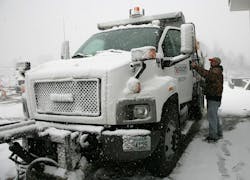Post-Hurricane Sandy efforts to re-open bridges, highways, and railroad tracks are shifting into high gear across the Mid Atlantic and Northeastern U.S., alongside initiatives to re-start public transit systems shut down ahead of the storm in New Jersey and New York City.
The Maryland State Highway Administration (SHA) continues to battle flooding, felled trees and darkened traffic signals in coastal and inland regions affected by the hurricane’s wind and rain, while simultaneously working to clear snow piling up in Maryland’s western mountains, the results of blizzards triggered by the so-called “Frankenstorm.”
“Our highway crews were not necessarily unprepared for the snow, as we typically deal with snow between October and March,” SHA spokeswoman Kelly Melham told Fleet Owner. “It’s just that the snowfall is so heavy and came down quickly that it proved difficult – dropping at one point one foot of snow in a hour.”
As of 6 a.m. this morning, 300 SHA crews remain deployed across the state dealing with snow as well as standing water on many roadways in the eastern part of Maryland, including the heavily traveled I-95 highway corridor.
As of this morning SHA noted that some 25 roadways remain temporarily closed, dozens of lane closures are in effect and more than 50 signals remain out. Motorists along coastal areas of the state should be mindful of high tides as this can present additional possible flooding concerns, warned SHA Administrator Melinda Peters.
"Although SHA crews have been responding around the clock and are diligently addressing the damage Sandy left in her wake, we are still seeing new high water closures as the tide moves in and expect to see additional felled trees,” she stressed.
In Western Maryland, SHA had I-68 west of Cumberland closed in all directions, as well as MD 495, US 40 and MD 42, all as a result of blizzard conditions. Three feet of snow has accumulated in parts of Western Maryland, cautioned Peters, noting that there are a number of emergency truck parking locations freight carriers can use if roads are too dangerous to travel due to the snowfall.
The West Virginia Division of Highways (DOH) is currently tackling up to three feet of snow dumped by the super storm system on its roadways, noting that it prepped maintenance crews in all 10 DOH districts ahead of the hurricane by testing plows and other snow equipment while readying chainsaws, generators and mobile messaging boards for deployment.
The Virginia Department of Transportation (VDOT) said that it has 1,000 crews and contractors working around the clock to deal with flooding, downed trees and snow/ice accumulation in the western portions of the state.
Some 280 mostly secondary roads remain closed due to flooding and downed trees and debris in the northern Virginia region, around Staunton and in eastern Virginia. VDOT is working to finish restoring 107 signals throughout northern Virginia knocked out by the hurricane and in Hampton Roads along the coast, all tunnels, water crossings, interstate highways and primary roads are open in most areas.
The Norfolk Southern (NS) freight railroad said minor flooding affected tracks in areas hit by Hurricane Sandy but that’s begun to subside. “We’re also working to clear snow from our tracks in western Virginia and West Virginia,” Robin Chapman, director of public relations for NS, told Fleet Owner.
The railroad also re-engaged intermodal services to accept shipments destined to its Morrisville, PA, and Baltimore, MD, terminals as of 3 p.m. yesterday.
Conditions are returning to normal in Pennsylvania, where the Pennsylvania Department of Transportation (PennDOT) and the Pennsylvania Turnpike Commission (PTC) lifted speed-limit and vehicle restrictions placed on roadways in the eastern and south central portions of the state due to the “super storm,” including the Delaware River Bridge and Fort Washington Interchange.
However, in the states hardest hit by Hurricane Sandy – New Jersey and New York especially – transportation restoration efforts are moving far more slowly, especially mass transit systems.
New York City’s Mass transit Authority (MTA) noted that both Long Island Rail Road and Metro-North Railroad service remains suspended today, as damage assessment and repair work continues on the nation’s two largest commuter railroads continues. All of the bridges operated by MTA are open to traffic, with the exception of the Cross Bay Bridge, while the Hugh L. Carey and Queens Midtown Tunnels remain closed.
The agency added that it is still too early to say how long it will take to restore the entire MTA system – especially the subway – to full service as damage from the hurricane is extremely heavy in downtown Manhattan where several subway lines converge. The South Ferry station is particular is filled track-to-ceiling with water as were several of subway tunnels, MTA said.
The New Jersey Office of Emergency Management, the New Jersey Department of Transportation and Board of Public Utilities are continuing statewide cleanup efforts and continue to advise drivers are advised to stay off of the roads whenever possible due to the continued threat of downed power lines, trees, branches, and the work of emergency management and utility crews.
New Jersey Governor Chris Christie noted in a televised press conference yesterday that that state closed 173 roadways and has deployed 450 high-water vehicles from National Guard units to aid in cleanup and transportation restoration efforts.
“There are no words to describe what the state of New Jersey has experienced,” the Governor said. “We have a long road ahead of us but I have every confidence we will come out of this better and stronger than before.”
About the Author
Sean Kilcarr
Editor in Chief
Sean Kilcarr is a former longtime FleetOwner senior editor who wrote for the publication from 2000 to 2018. He served as editor-in-chief from 2017 to 2018.
